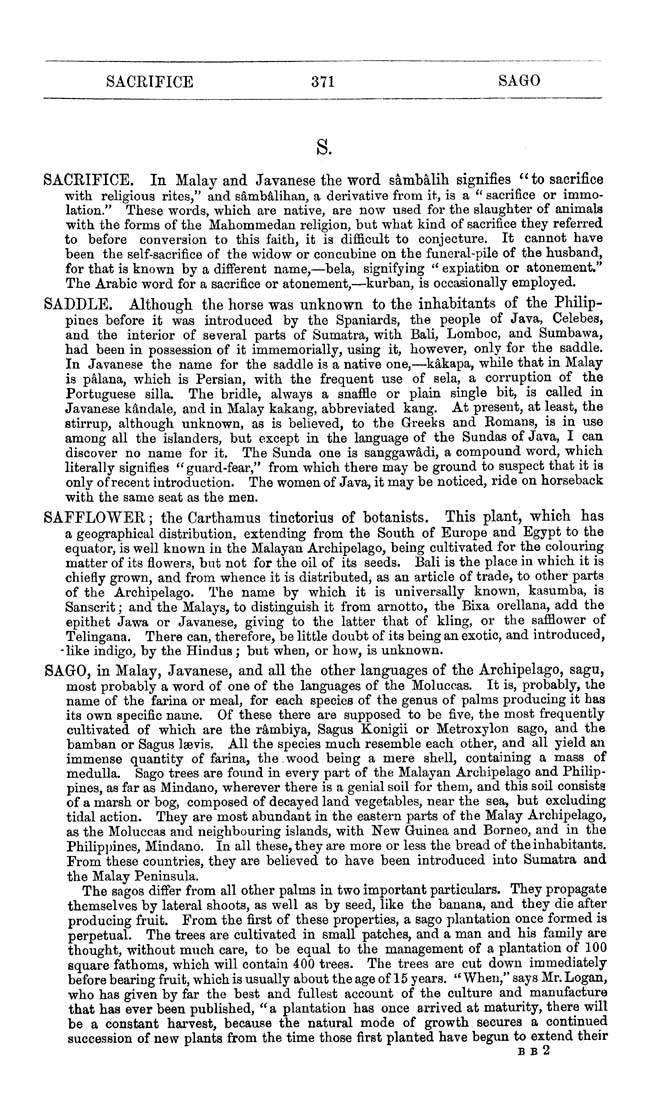SACRIFICE 371 SAGO
s.
SACRIFICE. In Malay and Javanese the word sambalih signifies *^to sacrifice
with religious rites," and s^mbMihan, a derivative from it, is a " sacrifice or immo¬
lation." These words, which are native, are now used for the slaughter of animals
with the forms of the Mahommedan religion, but what kind of sacrifice they referred
to before conversion to this faith, it is difi&cult to conjecture. It cannot have
been the self-sacrifice of the widow or concubine on the funeral-pile of the husband,
for that is known by a different name,—bela, signifying ** expiation or atonement."
The Arabic word for a sacrifice or atonement,—kurban, is occasionally employed.
SADDLE. Although the horse was unknown to the inhabitants of the Philip¬
pines before it was introduced by the Spaniards, the people of Java, Celebes,
and the interior of several parts of Sumatra, with Bali, Lomboc, and Sumbawa,
had been in possession of it immemorially, using it, however, only for the saddle.
In Javanese the name for the saddle is a native one,—kakapa, while that in Malay
is palana, which is Persian, with the frequent use of sela, a corruption of the
Portuguese silla. The bridle, always a snafile or plain single bit, is called in
Javanese k^ndale, and in Malay kakang, abbreviated kang. At present, at least, the
stirrup, although unknown, as is believed, to the Greeks and Romans, is in use
among all the islanders, but except in the language of the Sundas of Java, I can
discover no name for it. The Sunda one is sanggaw4di, a compound word, which
literally signifies " guard-fear," from which there may be ground to suspect that it is
only of recent introduction. The women of Java, it may be noticed, ride on horseback
with the same seat as the men.
SAFFLOWER; tlie Carthamus tinctorius of botanists. This plant, which has
a geographical distribution, extending from the South of Europe and Egypt to the
equator, is well known in the Malayan Archipelago, being cultivated for the colouring
matter of its flowers, but not for the oil of its seeds. Bali is the place in which it is
chiefiy grown, and from whence it is distributed, as an article of trade, to other parts
of the Archipelago. The name by which it is universally known, kasumba, is
Sanscrit; and the Malays, to distinguish it from arnotto, the Bixa orellana, add the
epithet Jawa or Javanese, giving to the latter that of kling, or the saflaower of
Telingana. There can, therefore, be little doubt of its being an exotic, and introduced,
-like indigo, by the Hindus ; but when, or how, is unknown.
SAGO, in Malay, Javanese, and all the other languages of the Archipelago, sagu,
most probably a word of one of the languages of the Moluccas. It is, probably, the
name of the farina or meal, for each species of the genus of palms producing it has
its own specific name. Of these there are supposed to be five, the most frequently
cultivated of which are the rambiya, Sagus Konigii or Metroxylon sago, and the
bamban or Sagus Isevis. All the species much resemble each other, and all yield an
immense quantity of farina, the.wood being a mere shell, containing a mass of
medulla. Sago trees are found in every part of the Malayan Archipelago and Philip¬
pines, as far as Mindano, wherever there is a genial soil for them, and this soil consists
of a marsh or bog, composed of decayed land vegetables, near the sea, but excluding
tidal action. They are most abundant in the eastern parts of the Malay Archipelago,
as the Moluccas and neighbouring islands, with New Guinea and Borneo, and in the
Philippines, Mindano. In all these, they are more or less the bread of the inhabitants.
From these countries, they are believed to have been introduced into Sumatra and
the Malay Peninsula.
The sagos differ from all other palms in two important particulars. They propagate
themselves by lateral shoots, as well as by seed, like the banana, and they die after
producing fruit. From the first of these properties, a sago plantation once formed is
perpetual. The trees are cultivated in small patches, and a man and his family are
thought, without much care, to be equal to the management of a plantation of 100
square fathoms, which will contain 400 trees. The trees are cut down immediately
before bearing fruit, which is usually about the age of 15 years. ** When," says Mr. Logan,
who has given by far the best and fullest account of the culture and manufacture
that has ever been published, " a plantation has once arrived at maturity, there will
be a constant harvest, because the natural mode of growth secures a continued
succession of new plants from the time those first planted have begun to extend their
B B 2
|








